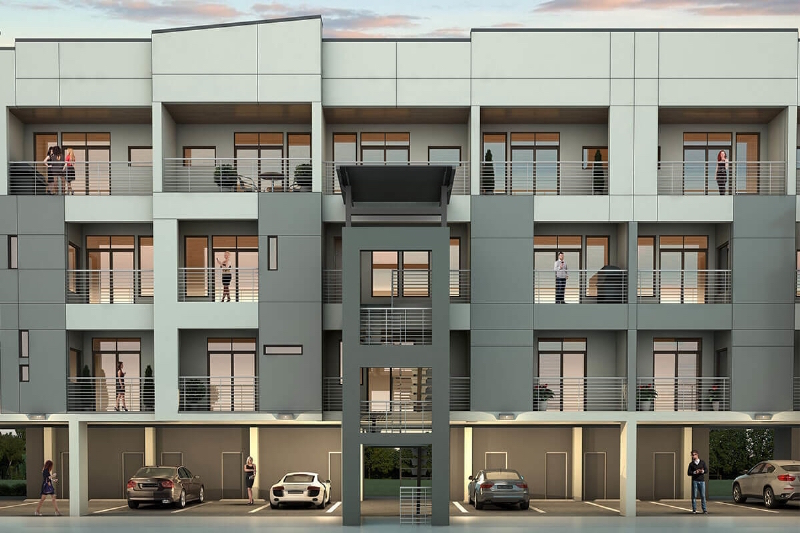The idea of micro condominiums, condos that are under 500 sf in size, is not new in densely populated cities such as New York or Tokyo, where sub-500-sf homes are not created to be hip and trendy, but, instead, are created out of necessity.
And while a city like Houston, and its population of just under 2.2 million certainly doesn’t categorize it as small, it also doesn’t make it a very dense city, either, especially when you take into account it is spread across 599.6 square miles (making it the ninth largest U.S. city by land area, ahead of New York, Los Angeles, and Chicago).
And yet, new home developer and builder Surge Homes has just announced its plans to deliver the first micro condos in Houston in 2017. The Hadley Building, part of the Parc at Midtown development, will include 14 micro condos among its total of 28 homes. The $21.6 million, 80-home community, Parc at Midtown, will mark the first Houston development with micro condos available for ownership.
All of the floor plans for Surge Homes’ micro condos will range from 414 sf to 498 sf. Although small, each condo will feature a closed master bedroom, space for entertaining in the living areas, and windows on the front and back exterior walls, providing a wealth of natural light.
While Houston may not be in need of micro condos, market research collected by Surge Homes of nearly 3,400 Houstonians gave some insight into the growing demand among Houston residents for these tiny homes. By being the first developer in Houston to offer micro condos, Surge Homes hopes to parlay its forward-thinking bet on these European-inspired floor plans into increased sales.
And they may already be seeing the payoff. The Parc at Midtown development, which features more traditionally sized homes, as well, has sold 55 percent of its homes in 120 days, making it the third fastest-selling residential subdivision in Houston for the first quarter of 2016, according to Meyers Research LLC.
 A typical Hadley Building condominium kitchen featuring optional integrated refrigerator. Image: PRNewsFoto/Surge Homes
A typical Hadley Building condominium kitchen featuring optional integrated refrigerator. Image: PRNewsFoto/Surge Homes
Related Stories
Urban Planning | Jun 15, 2023
Arizona limits housing projects in Phoenix area over groundwater supply concerns
Arizona will no longer grant certifications for new residential developments in Phoenix, it’s largest city, due to concerns over groundwater supply. The announcement indicates that the Phoenix area, currently the nation’s fastest-growing region in terms of population growth, will not be able to sustain its rapid growth because of limited freshwater resources.
Multifamily Housing | Jun 15, 2023
Alliance of Pittsburgh building owners slashes carbon emissions by 45%
The Pittsburgh 2030 District, an alliance of property owners in the Pittsburgh area, says that it has reduced carbon emissions by 44.8% below baseline. Begun in 2012 under the guidance of the Green Building Alliance (GBA), the Pittsburgh 2030 District encompasses more than 86 million sf of space within 556 buildings.
Industry Research | Jun 15, 2023
Exurbs and emerging suburbs having fastest population growth, says Cushman & Wakefield
Recently released county and metro-level population growth data by the U.S. Census Bureau shows that the fastest growing areas are found in exurbs and emerging suburbs.
Engineers | Jun 14, 2023
The high cost of low maintenance
Walter P Moore’s Javier Balma, PhD, PE, SE, and Webb Wright, PE, identify the primary causes of engineering failures, define proactive versus reactive maintenance, recognize the reasons for deferred maintenance, and identify the financial and safety risks related to deferred maintenance.
Mixed-Use | Jun 12, 2023
Goettsch Partners completes its largest China project to date: a mixed-used, five-tower complex
Chicago-based global architecture firm Goettsch Partners (GP) recently announced the completion of its largest project in China to date: the China Resources Qianhai Center, a mixed-use complex in the Qianhai district of Shenzhen. Developed by CR Land, the project includes five towers totaling almost 472,000 square meters (4.6 million sf).
Mixed-Use | Jun 6, 2023
Public-private partnerships crucial to central business district revitalization
Central Business Districts are under pressure to keep themselves relevant as they face competition from new, vibrant mixed-use neighborhoods emerging across the world’s largest cities.
Multifamily Housing | Jun 6, 2023
Minnesota expected to adopt building code that would cut energy use by 80%
Minnesota Gov. Tim Walz is expected to soon sign a bill that would change the state’s commercial building code so that new structures would use 80% less energy when compared to a 2004 baseline standard. The legislation aims for full implementation of the new code by 2036.
Student Housing | Jun 5, 2023
The power of student engagement: How on-campus student housing can increase enrollment
Studies have confirmed that students are more likely to graduate when they live on campus, particularly when the on-campus experience encourages student learning and engagement, writes Design Collaborative's Nathan Woods, AIA.
Multifamily Housing | Jun 1, 2023
Income-based electric bills spark debate on whether they would harm or hurt EV and heat pump adoption
Starting in 2024, the electric bills of most Californians could be based not only on how much power they use, but also on how much money they make. Those who have higher incomes would pay more; those with lower incomes would see their electric bills decline - a concept known as income-based electric bills.
Multifamily Housing | May 30, 2023
Boston’s new stretch code requires new multifamily structures to meet Passive House building requirements
Phius certifications are expected to become more common as states and cities boost green building standards. The City of Boston recently adopted Massachusetts’s so-called opt-in building code, a set of sustainability standards that goes beyond the standard state code.

















